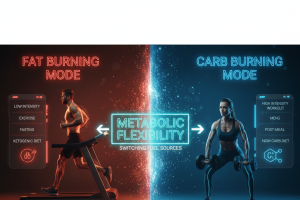Cold Exposure and Heat Therapy: Benefits for Athletic Performance

Cold Exposure and Heat Therapy: Benefits for Athletic Performance
As a means of promoting athletic performance, rehabilitation, and general physical resilience, heat treatment and cold exposure are being used more and more by athletes and fitness aficionados. Thermotherapy, which is also known as “heat,” and cryotherapy, which is also known as “cold,” are the names that are often used to refer to both methods of treatment. The body’s inherent physiological reactions to temperature extremes are harnessed by these methods. Athletes may increase circulation, decrease inflammation, hasten the healing process, and even enhance mental concentration by making use of cold or heat therapy in a planned manner. In order to maximize the results of training and to provide assistance for athletes in the long run, it is necessary to have a thorough comprehension of the mechanics and advantages of these treatments.
Cryotherapy for Recovery and Performance: The Benefits of Cold Exposure
Cryotherapy, often known as cold exposure, is subjecting the body to low temperatures for a brief amount of time. Examples of this include taking cold showers, soaking in ice baths, applying ice packs to specific body parts, or undergoing full-body cryotherapy. The main advantages associated with being exposed to low temperatures are the ability to manage inflammation, alleviate pain, and expedite the healing process. Vasoconstriction, which is the narrowing of blood vessels, occurs when muscles are subjected to cold temperatures. This physiological response is beneficial in that it reduces inflammation and eliminates metabolic waste products that have built up during strenuous activity. Following the session, the body undergoes vasodilation, which enhances the flow of blood and the supply of nutrients to tissues. This process facilitates a quicker recovery and repair.
Decreasing Muscle Soreness and Inflammation
After exercises that are novel or of high intensity, it is not uncommon for delayed onset muscle soreness (DOMS) to occur. It has been shown that cold treatment may decrease the degree of difficulty associated with delayed onset muscle soreness (DOMS) by restricting inflammation that is brought on by microtrauma. The application of ice or immersion in ice may lead to a reduction in the sense of pain, an improvement in comfort levels after vigorous activity, and a decrease in the excitability of the nerves. Many athletes may purposefully expose themselves to low temperatures in order to maintain their performance levels and minimize the amount of time they spend between exercises while they are recuperating from intense training sessions or contests.
Thermotherapy for the Purpose of Enhancing Circulation and Flexibility
Methods like saunas, steam rooms, warm baths, and targeted heat packs are all examples of the several ways that warmth may be applied to muscles or the whole body in order to accomplish heat treatment. Increased blood flow due to heat results in more effective delivery of oxygen and nutrients to muscles, as well as the removal of metabolic wastes. In addition to aiding in the process of healing, this improved circulation also gets the muscles ready for physical activity via the enhancement of their suppleness, flexibility, and range of motion. When used before stretching or mobility exercises, heat treatment is very useful in minimizing the likelihood of injuries.
Management of Pain and Muscle Relaxation
Thermotherapy has been shown to relieve stiffness, relax tight muscles, and alleviate tension that has been brought on by repeated training or continuous periods of exercise. The use of heat treatment may be a beneficial tool for both recovery and pre-training preparation since it helps to alleviate pain in soft tissues and joints by raising the temperature of the tissue. This calming effect also plays a role in enhancing sports performance and increasing the efficiency of one’s movements.
A Contrast Between Cold and Heat Therapy
In order to optimize recuperation and circulation, some athletes make use of contrast treatment, which involves alternating between exposure to cold and heat. The quick transition between vasoconstriction, which is also known as coldness, and vasodilation, which is also known as heat, produces a pumping action in the blood vessels, which increases the supply of nutrients and the elimination of waste products in the muscles. This approach has the potential to decrease the amount of time it takes for healing to occur, lessen the feeling of tiredness, and increase the general effectiveness of the muscles. Contrast therapy has been shown to have the potential to accelerate the recovery of the neurological system, which may lead to improvements in mental alertness and coordination after intense exercise routines, according to recent research.
Advantages on the Hormonal and Cellular Levels
Exposure to frigid temperatures and heat treatment have an impact on the hormonal reactions that assist in sports performance. When a person is exposed to cold temperatures, the levels of norepinephrine in their body may rise, which can lead to improvements in their alertness, attention span, and metabolism of fats. Increasing the synthesis of growth hormone using methods such as heat treatment, for example by using a sauna, may assist in the healing of tissues, promote muscular development, and regulate metabolism. Furthermore, cellular adaptations may be initiated by temperature stress. These adaptations include increased antioxidant defenses and increased efficiency of mitochondria, which both contribute to endurance and resilience over an extended period of time.
The ability to concentrate and adapt to stress
The nervous system is put to the test when it is exposed to severe temperatures, which in turn encourages the development of psychological resilience. Controlled breathing and mental attention are both required for exposure to cold temperatures, which may help to increase concentration during training or competition and can also assist stress management. Lowering cortisol levels and bolstering the body’s capacity to respond to stress in a healthy way are two of the benefits of heat treatment, which also helps to promote relaxation and healing. The use of these therapeutic approaches in combination has the potential to assist athletes in sustaining their mental and physical performance when confronted with challenging circumstances.
Real-world uses for sports players
- Before working out, use heat treatment to promote muscular flexibility, warm up the muscles, and lower the likelihood of sustaining an injury.
- After exercising, it is recommended that you use cold exposure in order to decrease inflammation, speed up healing, and lessen the severity of muscle pain.
- Contrast therapy: Take turns between sessions of heat and cold in order to improve circulation and waste clearance.
- The use of consistent, selective cold or heat sessions, as opposed to intense sessions every day, may enable the body to adjust in a safe manner.
Things to Think About Regarding Safety
Although there are a number of advantages that may be gained from both heat therapy and exposure to cold, the inappropriate application of both treatments might result in negative consequences such as frostbite, heat exhaustion, or cardiovascular strain. Sessions should be matched to the individual’s tolerance, health state, and training intensity. It is particularly suggested for athletes who have pre-existing ailments or who engage in high-intensity training regimens to undergo a process of gradual adaptation and to get supervision from a specialist.
Heat treatment and exposure to cold are both effective methods for increasing physical resilience, speeding up recovery time, and improving athletic performance. On the one hand, cold treatment is able to decrease inflammation, relieve discomfort, and promote metabolic activity; on the other hand, heat therapy has been shown to increase circulation, flexibility, and muscle relaxation. When used in a strategic manner—either independently or in conjunction with other methods—these therapeutic approaches are able to expedite the healing process, increase performance, and boost mental concentration. As a result of the continued discovery of the physiological and cellular advantages of temperature-based treatments by researchers, it is probable that cold and heat therapies will become routine components of complete training and recovery regimens for athletes in the future.








